FN P90 PROTOTYPES
In the mid 1980s Fabrique Nationale began working on a new personal defence weapon. While P90s full development history of is still relatively unknown, it is known that Jean-Paul Denis and Marc Neuforge developed the 5.7x28mm SS90 round to replace the 9x19mm commonly used in submachine guns. FN developed the SS90 to create a low-recoil, high stopping power projectile. In 1989, NATO issued a specification for two personal defence weapons, one a pistol and the other shoulder fired compact weapon. The pistol was to weigh less than 1kg while the shoulder fired weapon would weigh less than 3kg. Both weapons were to fire a cartridge with improved range, accuracy and terminal ballistic performance in comparison to 9x19mm.
NATO planned to equip rear-echelon troops with these new personal defence weapons, personnel who couldn’t carry or didn’t need a standard issue rifle. NATO believed that in the event of war Soviet special forces would attempt to disrupt Western lines of communication and logistical efforts, so a weapon firing a round that could penetrate Soviet body armour at close ranges was desirable.
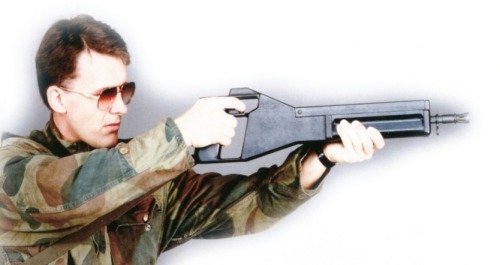
Demonstration of aiming a P90 Prototype (source)
FN’s answer to this specification had been in development since 1986, and had evolved from several unusual prototypes. However, the unifying aspect of the designs were the SS90 cartridge and the high capacity horizontal magazine. The photographs above show two of the early incarnations of FN’s design. The Hill submachine gun’s design appears to have influenced the P90’s design, incorporating a feed-system that turned the bullet in the weapon rather than in the feedway of the magazine (see image #2).
The first prototype appears to be a shoulder fired design (see image #1) while the second is a handheld, point shoot weapon (see image #2). It is unclear from the photograph where the user inserted the first prototype’s magazine but the second photograph shows that the magazine was placed on top of the barrel. In 1989, Rene Predazzer patented a top-mounted horizontal magazine which incorporated a spiral feedway which rotated the cartridge before it entered the weapon’s action. This loading system came to define the P90′s design.
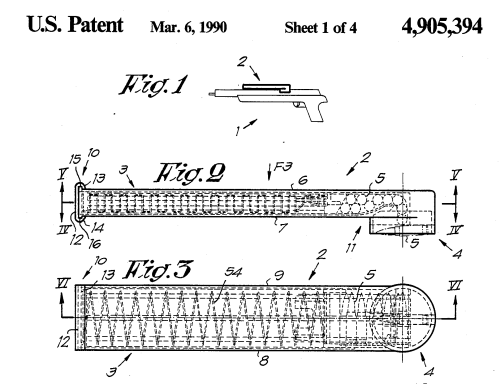
Rene Predazzer’s top mounted longitudinal magazine (source)
In 1988, FN announced the development of the P90, and in 1990, launched the new weapon. In 1992, FN refined the P90′s 5.7×28mm ammunition shortening the projectile slightly. The new SS190 round was 2.7mm shorter but had slightly more mass with an aluminium core. In 1993, FN redesigned the P90 and its magazine to chamber the new SS190 round. It would be a decade before NATO finally evaluated the P90 and its 5.7mm round. In 2002, NATO trials began pitting the FN 5.7x28mm round against the rival 4.6x30mm round developed by Heckler & Koch. The trials found the 5.7mm round to be superior but Germany rejected the trials’ recommendation and NATO standardised to neither round.
In January 1995, Predazzer patented an unconventional pistol design which incorporated his top loaded longitudinal magazine. This appears to be an evolution of the second handheld prototype (see image #2) and in theory fulfilled the pistol element of NATO’s Personal Defence Weapon specification. Several years later, in 1998, the design of FN’s 5.7x28mm pistol, the Five-Seven, was finalised and launched.
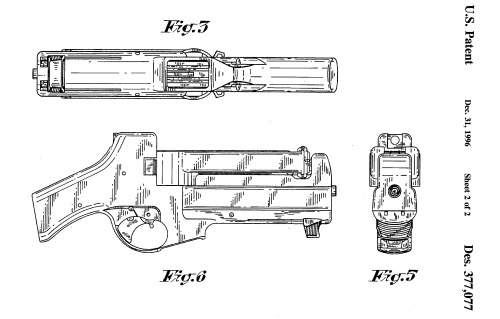
Rene Predazzer’s unconventional pistol design incorporating his longitudinal magazine, patented in 1996 (source)
The final design (see image #3) uses a blowback action and fires from a closed bolt which improves the weapon’s accuracy. Feeding from a 50-round magazine, the P90 is fully ambidextrous with two sets of back-up sites mounted either side of its collimating optical sight, charging handles and magazine release catches either side and an ambidextrous safety located just below the trigger. The design makes use of new polymers, the translucent magazine itself is made from polycarbonate. Despite its unusual shape the P90 is an ergonomic weapon which is easy to quickly master. The P90 is an extremely flat shooting automatic weapon despite its high, 900 rounds per minute, cyclic rate. It has been adopted by over a dozen nations, primarily for special operations and counter terrorism units while Belgium is the only country to have adopted it for its original purpose to arm rear echelon troops.
Sources:
‘In The Line of Fire’, Global Defence Review, D. Oliver, (2006),[source]‘Top mounted longitudinal magazine’, US Patent #4905394, R. Predazzer, 06/03/1990 (source)‘High-performance projectile’, US Patent #5012743, J. Denis & M. Neuforge, 07/05/1991 (source)
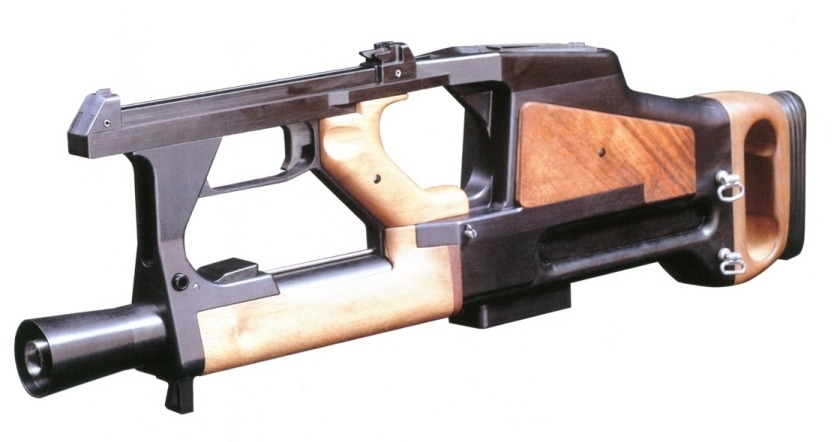
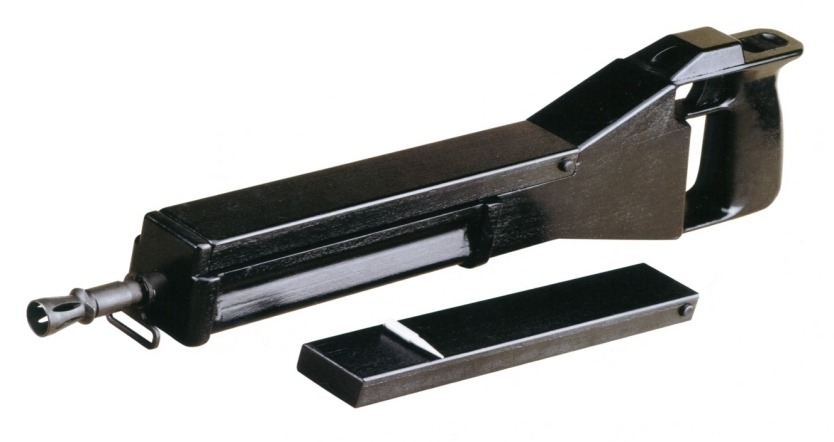
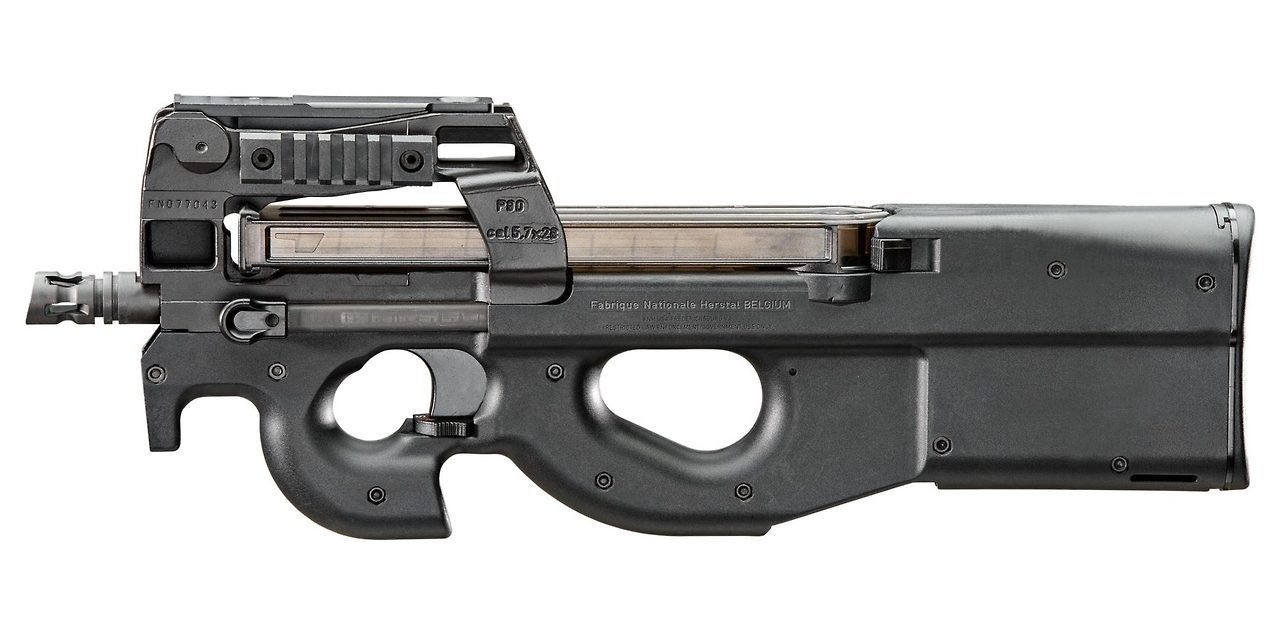
No comments:
Post a Comment